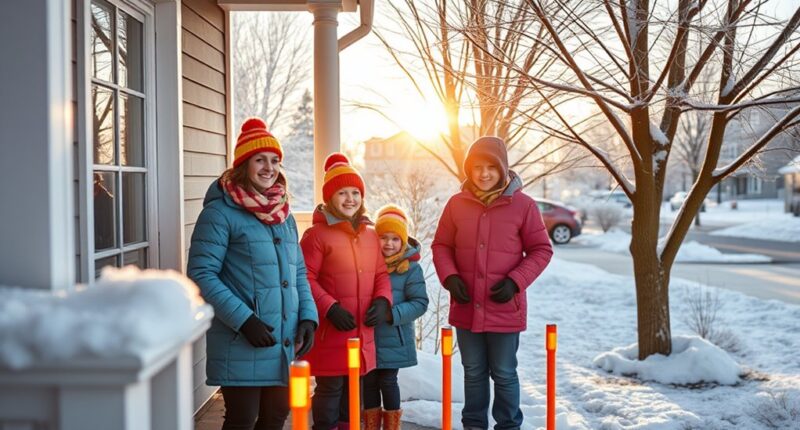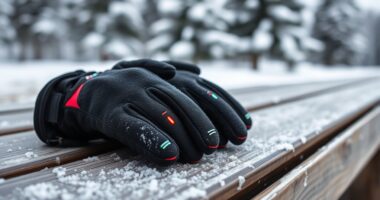To keep your family safe during winter, I recommend preparing a 72-hour emergency kit with water, non-perishables, and first aid supplies. Monitor weather forecasts daily and stay updated on alerts. Confirm your home has proper insulation and safe heating sources with working smoke and CO detectors. Dress in layered winter clothing and keep vehicle supplies ready. Learn about local shelters and communicate plans with family. Continue to explore essential tips that will help you stay prepared and protected all season long.
Key Takeaways
- Prepare an accessible emergency kit with water, food, medications, and cold-weather gear for at least 72 hours.
- Monitor local weather alerts regularly and establish a family communication plan with designated contacts and meeting points.
- Ensure heating devices are safe, install smoke and carbon monoxide detectors, and use proper winter clothing layers.
- Identify and plan routes to nearby warming centers and shelters, confirming hours, capacity, and transportation options.
- Stay informed about local emergency services, community support programs, and evacuation procedures for winter storms.
72 HRS Deluxe Emergency Survival Kit

If you’re looking for a reliable way to keep your family safe during winter emergencies, the HRS Deluxe Emergency Survival Kit is an excellent choice. This heavy-duty 72-hour bag is designed to handle earthquakes, hurricanes, winter storms, and blackouts. It guarantees you’re prepared for unexpected situations by providing essential tools and supplies, including an emergency first aid kit, water, and food. With this kit, you gain peace of mind knowing you’re ready to address immediate needs quickly. Its versatility makes it a crucial part of any safety plan, empowering you to protect your loved ones during any crisis.
Best For: families and individuals seeking reliable emergency preparedness for natural disasters and winter storms.
Pros:
- Comprehensive kit including first aid supplies, water, and food for immediate needs
- Heavy-duty bag designed for durability and long-term use during crises
- Versatile for various emergency scenarios such as earthquakes, hurricanes, and blackouts
Cons:
- May be bulky to carry or store due to its 72-hour capacity
- Could require additional personal items to meet specific family needs
- Price may be higher compared to basic emergency kits with fewer contents
Factors to Consider When Choosing a Family Winter Safety Plan

When creating a winter safety plan, I focus on making sure our emergency kit is fully stocked and ready to go. I also keep a close eye on weather forecasts and guarantee our heating safety measures are in place. Additionally, I plan our family communication and dress everyone in appropriate winter layers to stay safe and warm.
Emergency Kit Readiness
Choosing the right emergency kit is a crucial step in preparing your family for winter hazards. I make sure it contains enough water, non-perishable food, and essential supplies to last at least 72 hours. First aid supplies and necessary medications are kept accessible, so we can respond quickly if needed. I store the kit in a spot everyone knows and can reach easily, like a closet or garage. Regularly, I check the contents to confirm items are in good condition and haven’t expired. Since winter brings specific risks, I include cold-weather gear and items to prevent frostbite and hypothermia. Tailoring the kit to these hazards ensures we’re better prepared for any emergency, giving my family peace of mind during harsh winter conditions.
Weather Forecast Monitoring
Staying updated on the latest weather forecasts is a vital part of our winter safety plan. I check local weather reports regularly to stay informed about storm warnings and advisories. I use multiple sources like apps, radio, and online services to get real-time updates on severe conditions. Paying attention to temperature trends, snowfall predictions, and ice accumulation helps me prepare the right gear and supplies for my family. I also monitor weather alerts from official agencies to receive timely notifications about changing conditions or emergency instructions. Incorporating forecast information into our safety plan allows us to adjust activities, plan travel routes, and guarantee emergency readiness. Staying proactive with weather updates keeps my loved ones safe and helps us respond quickly to winter hazards.
Heating Safety Measures
Selecting the right heating safety measures is essential for keeping your family safe during winter. I always make sure our heating devices are properly installed and regularly maintained to prevent fire hazards. Keeping combustible materials at least three feet away from heat sources, like space heaters and fireplaces, is a simple but critical step. I’ve installed smoke and carbon monoxide detectors on every level of our home and test them monthly to confirm they’re working. When using space heaters, I choose models with automatic shut-off features and never leave them unattended. Additionally, I prepare a backup power source or alternative heating method in case of power outages during winter storms. These measures help protect my family and give me peace of mind during the cold months.
Family Communication Plan
During winter emergencies, having a reliable family communication plan is vital to keep everyone safe. I recommend establishing both a primary and secondary way to stay in touch, like phone calls, texts, or social media, especially during power outages or network disruptions. It’s also essential to designate an out-of-area emergency contact who can relay information if local lines fail. Creating clear meeting points and check-in procedures helps confirm everyone’s safety quickly. Practice your plan regularly through drills so all family members know how to reach each other in different scenarios. Keep important contact information accessible in multiple locations—wallets, phones, or printed lists—so you’re always prepared. A well-thought-out plan ensures everyone stays connected and safe during winter emergencies.
Winter Clothing Layers
Choosing the right winter clothing layers is vital for keeping your family warm and safe in cold weather. I always emphasize a three-layer system: a moisture-wicking base layer, an insulating middle layer, and a waterproof outer layer. Proper layering traps body heat and prevents hypothermia and frostbite. I prefer thin layers over one bulky garment because they offer better insulation and flexibility. Materials like wool and synthetic fibers are ideal for base layers because they stay warm even when damp. It’s also essential to adjust layers based on activity level and weather changes. For active moments, lighter layers prevent overheating, while adding layers during rest keeps everyone cozy. Thoughtful layering ensures your loved ones stay warm, dry, and protected against winter’s harsh conditions.
Home Insulation Quality
Because high-quality home insulation plays a crucial role in winter safety, it’s important to take into account several factors when planning your family’s heating strategy. Good insulation reduces heat loss, keeping your home warmer and more comfortable throughout the colder months. It also minimizes drafts and cold spots, ensuring a consistent indoor temperature. Proper insulation can lower your energy bills by reducing heating needs, which benefits both your wallet and the environment. When selecting insulation materials like foam, fiberglass, or cellulose, consider their R-value, as this influences their effectiveness in winter conditions. Regular inspection and maintenance are essential to prevent moisture buildup and mold growth, which can compromise safety and efficiency. Investing in quality insulation is a key step toward a safer, warmer home for your loved ones.
Vehicle Preparedness Supplies
Preparing your vehicle for winter isn’t just about driving skills; it’s about equipping it with the right supplies to handle emergencies. I make sure to keep an emergency kit that includes blankets, non-perishable snacks, water, and a flashlight— essentials if you get stranded. A fully charged mobile phone with a portable charger is a must for staying connected. I also keep snow brushes, ice scrapers, and traction aids like sand or cat litter to improve grip on icy roads. Regularly checking antifreeze levels, tire pressure, and battery health helps prevent breakdowns. Additionally, I carry a reflective warning triangle or roadside flares to boost visibility during emergencies. Being prepared with these supplies gives me peace of mind and ensures my family’s safety during winter drives.
Local Emergency Resources
Having the right vehicle supplies is just one part of winter safety; knowing how to access local emergency resources makes a big difference during storms. I recommend familiarizing yourself with nearby shelters, community centers, and support services beforehand. Keep a list of emergency contact numbers for local authorities, hospitals, and utility providers where everyone in the family can easily find it. It’s also smart to identify the locations of warming centers or shelters in case of prolonged power outages. Staying informed is vital—subscribe to official weather alerts and community notification systems to receive timely updates. Finally, understand what local agencies offer during winter emergencies, such as assistance programs or evacuation procedures. Being prepared with this knowledge ensures you can respond quickly and keep your loved ones safe during severe weather events.
Frequently Asked Questions
How Often Should I Update My Winter Safety Kit?
I recommend updating your winter safety kit at least once a year, ideally before the coldest months arrive. Check for expired items, replace any worn-out gear, and add new essentials like fresh batteries or updated medications. If there’s a winter storm or emergency, review and refresh your kit immediately. Staying proactive guarantees your family stays safe and prepared throughout the season, giving you peace of mind.
What Are Common Winter Hazards Not Covered in the Plan?
Winter hazards often overlooked include icy sidewalks, frozen pipes, and poor visibility due to snowstorms. These dangers can cause slips, water damage, or accidents. I’ve learned to look out for these hazards by inspecting walkways, insulating pipes, and staying informed about weather updates. Staying cautious about these common issues helps keep everyone safe and sound during the chilly months, ensuring we’re prepared for whatever winter throws our way.
How Can I Involve Children in Safety Preparations?
I involve children in safety preparations by turning it into a fun learning activity. I explain winter hazards in simple terms, then let them help check smoke detectors or pack emergency kits. We practice fire drills together, making it engaging. This way, they feel responsible and confident. Plus, it’s a great opportunity to teach them important safety habits that will stay with them for life.
What Are Signs of Hypothermia in Family Members?
Think of hypothermia as your body’s cold warning system. I watch for shivering, confusion, and slurred speech—early signs that tell me to act fast. If someone’s lips turn blue or they become drowsy and unresponsive, I know it’s serious. I stay calm, get them warm, and seek medical help immediately. Recognizing these signs quickly can be the difference between a close call and a crisis.
How Do I Customize Safety Plans for Elderly Relatives?
To customize safety plans for elderly relatives, I start by evaluating their specific needs and health conditions. I ensure their home is well-heated, install grab bars, and keep emergency supplies nearby. I also set up regular check-ins via calls or visits, and teach them how to recognize hypothermia symptoms. Personalizing these steps makes sure they stay safe, comfortable, and independent during winter months.
Conclusion
By preparing a reliable emergency kit, monitoring weather updates, ensuring heating safety, dressing appropriately, and checking home and vehicle readiness, you create a strong safety net for your loved ones. Staying informed, staying prepared, and staying cautious are your best tools during winter’s challenges. Remember, safety is a priority, safety is a responsibility, and safety is a choice. Let’s commit to protecting our families and making this winter the safest one yet.









